Cycling has been a passionate sport and hobby of mine for decades. I am no longer a professional bike racer; I am now a mother and Gokhale Method® teacher. As a result, I have become more observant of what can “go wrong,” posturally speaking, when riding a bicycle. And I work to improve my posture as I pedal. For example, it takes vigilance to keep my shoulders back and my head aligned with my torso. I now know how cycling can enhance my form, and vice versa. I also enjoy modeling key posture principles to guide my daughters and partner so that they too can be comfortable and healthy on a bicycle.
Cycling is a part of family life
In this blog post I would like to share with you some of the cycling activities and posture tips that have benefitted us as a family. Prior to parenthood, my partner and I raced and trained together for many years, traveling to quite a few states and even abroad to indulge our passion. When our daughters were born, we decided that, at least in our busy city, Somerville, MA (the most densely populated city on the Eastern Seaboard, USA!), we would get about with them on bicycles instead of driving.
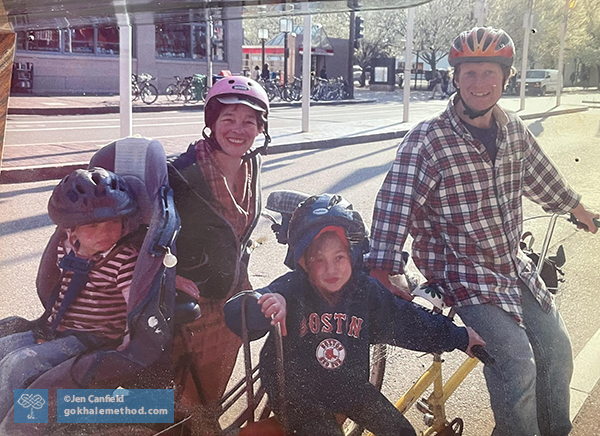
Here I am supporting a customized cruiser with our daughter, Willa, aged two, in a car seat on the back. My partner, Skip, sits on a customized tandem with Coco, aged five. Car seats worked well as carriers and even allowed Willa to nap during our outings. Can you make out the second car seat on the front of my cruiser?
Of necessity, we hauled our young daughters around on homemade bicycle “carrier-cruisers,” with car seats attached. Both bikes offered comfortable arrangements for young children—and great exercise for us parents! These days, there are so many choices of bicycles made for transporting children, it might feel overwhelming and hard to know where to start. Bike shops are now a terrific resource, happy to offer guidance and expertise, help with fittings and even track down special equipment if needed. With so many options out there, including information on the internet, you won’t have to customize your own bicycle unless you want to.
Cycling makes a better world for our children
We know it’s better for our environment to cycle than to drive everywhere. Some people choose to live car-free, and that certainly saves money, as well as the planet! We are thankful for the bike lanes that are becoming a more prevalent part of the infrastructure in cities and suburbs alike. As bike lanes make cycling more accessible, you’ll find more people of all ages pedaling instead of driving, which in turn makes it safer for everyone.
Charity rides or fundraisers are a great way to enjoy family time together while also supporting good causes. These benefit rides are usually closed to traffic, or directed by officials, which makes the ride casual and relaxed. Varied routes are offered, making the event open to a wider range of ability and fitness levels.
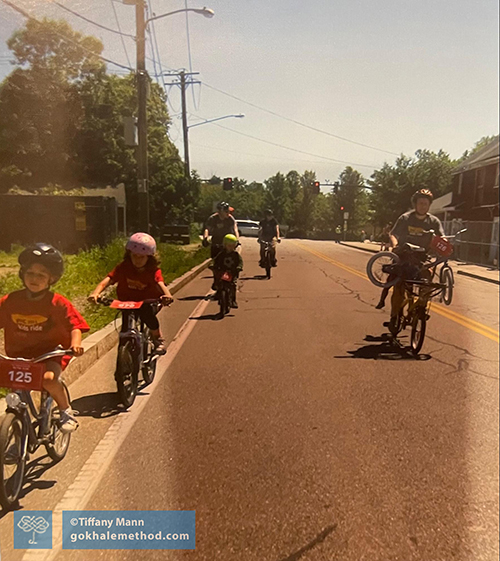
Here we are doing a kids Pan-Mass Challenge, raising money for cancer research and treatment. Coco, aged five, is leading the pack on this 10K ride.
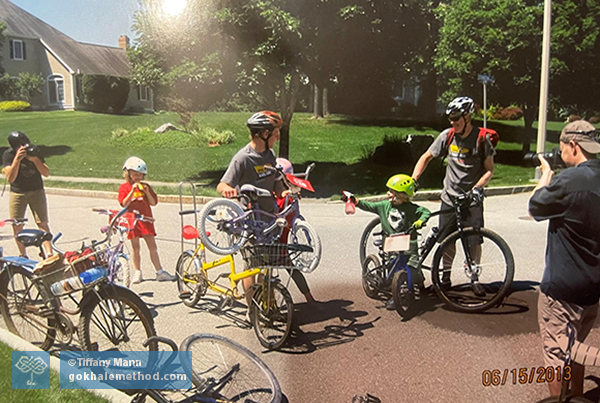
Notice the two photographers’ interest in Skip’s bicycle arrangement, with the little bike attached by bungees to the front so that Willa, aged two and a half, could ride a bit of the course too.

The Graves family has just completed the D2R2 (The Deerfield Dirt Road Randonée) fundraiser ride. They chose the moderate, yet challenging, 48.6-mile route, and will celebrate with a refreshing plunge in the river, and a BBQ for a refuel. Their son is just nine years old—the family that rides together, has fun together!
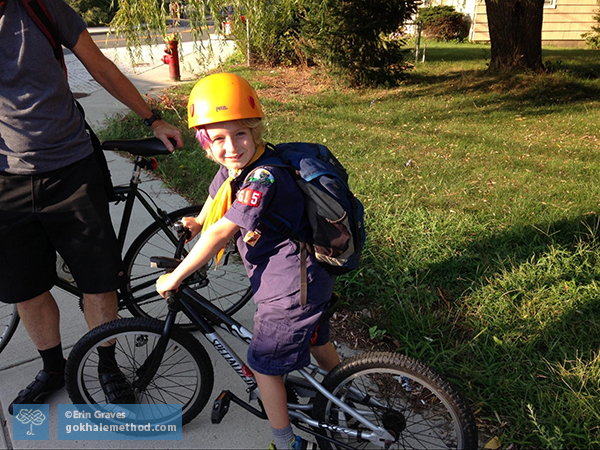
Here is Lloyd Graves aged seven, getting ready to bike to school with his dad. Studies¹ have shown that children who walk or ride their bicycle to school are more engaged and ready to learn than those who have been driven to school. Their circulatory system is boosted, and also their executive functioning is activated and neural pathways have been firing, both being used to make decisions before even entering the classroom.
Now that my daughters are 15 and 12, they’re ready to explore the world on their own to a degree. By cycling they now have the skills and self-confidence to ferry themselves around our city to meet up with friends or attend their extracurricular activities.
We all need bikes that fit our bodies!
You can consider bicycles as an extension of the human body, and both adults and children need bikes that fit them, for efficiency, safety, and enjoyment. Most often an ill-fitting bicycle is too small, which forces hunching and rounding of the shoulders and compression of the whole spine—neither of which are helpful for your posture or body mechanics. As kids grow so quickly it is especially important to watch out for this. With the right size, and sometimes even type of bicycle, it is possible to enjoy all the benefits of cycling from being very young until well into old age.
 ›
›
Rachel Holt on tricycle, Dummer, New Hampshire, about 1927. This is a charming portrait. From a cycling perspective, Rachel could do with a bigger bike, so that her thighs can drop down and she no longer has to tuck her pelvis and round her back. She will also be able to pedal a lot more efficiently! Jim Griffin
A bicycle that is too big may have a child too stretched out to reach the handlebars comfortably, and/or bouncing on the saddle in an effort to reach the pedals, which stresses the hips. It can also be a challenge to maneuver, adding unnecessary strain and making it unsafe.
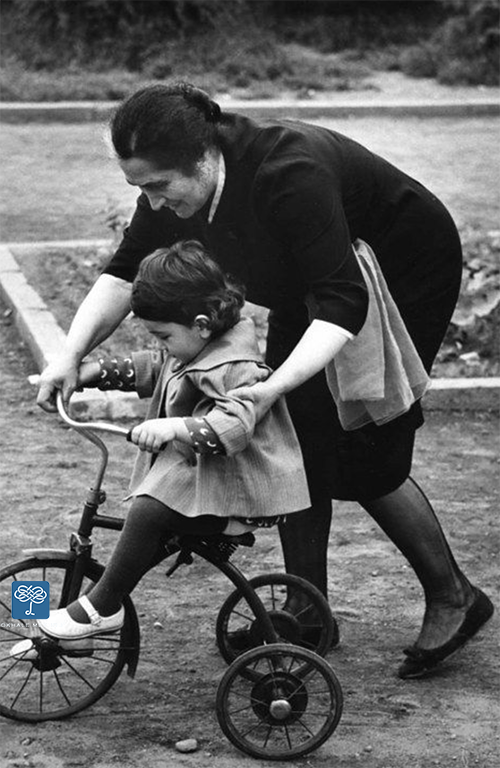
This tricycle is still a little too big for its rider to reach the pedals and the ground—though she’ll soon grow into it! kenheyman.com
The benefits of balance bikes
We can begin bike riding at an early age, and even new walkers or soon-to-be walkers, can consider using a “balance bike.” They have some advantages over a tricycle. Balance bikes are built without pedals, so the novice rider can focus on balance and steering. (Pedals can also be taken off some bikes, then put back on when the child is ready.) With balance bikes, all the propulsion is with the feet actively pushing the ground away and behind, so there is a natural tendency for the body to adopt a position of biomechanical advantage by sitting with a tipped forward pelvis. This is an example of posture aiding our movement; when the feet go behind our hips, they can better push the ground away from us. This action comes readily since little children aren't fighting a tight psoas, or struggling with stiff joints. This is an action we would like our feet to do in walking, which is to actively engage with pushing on the ground beneath us. It is amazing how fast tiny children can propel themselves using just their feet to paddle along!

Our daughter Willa, aged 11 months, scooting along on her Strider® balance bike. Notice how she keeps her shoulders back and leans slightly forward. Balance bikes encourage children to propel themselves with natural foot strength.
Another benefit to learning to ride without pedals is that, by definition, a child can easily reach the ground, so a parent is not pushing or guiding from behind or towing the handlebars in an effort to help the child maintain balance. This often sees the parent adopt a very compromised position, hunching over and distorting the back. Best to help the child learn to ride solo; take them to a grassy area or quiet, dead-end street or parking lot where they can let fly!
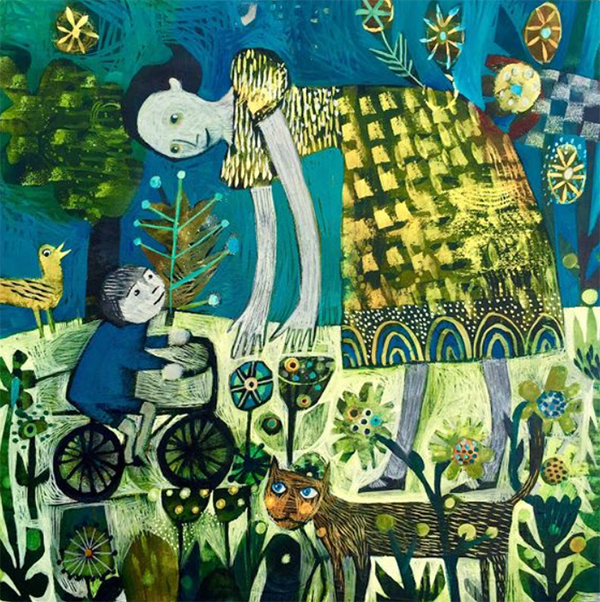
This beautiful illustration shows the mother maintaining a straight back as she bends forward to guide her child learning to ride. Most parents do not bend so well, causing cumulative damage to their spinal discs. Esté MacLeod
Modeling healthy posture for your children
One of the best ways a parent can encourage their children to maintain healthy posture on a bike is to model it themselves. For example, once you get used to sitting with the behind behind and the pelvis tipped forward rather than tucked under, it is not only comfortable, but, pretty soon, preferred. We teach a similar style of sitting in the Gokhale Method called stacksitting, for when you don’t have a backrest for support. You can learn how to stacksit here.
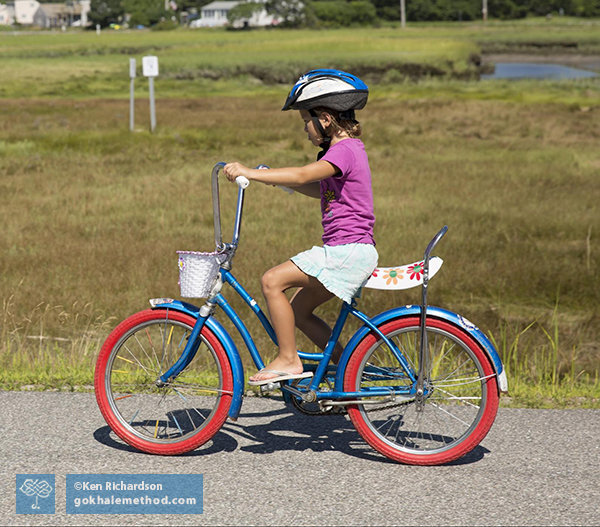
Willa, aged four, sitting forward enough on her “banana” seat to comfortably reach the handlebars and maintain her shoulders back. See how she stacksits beautifully, with her back straight and behind behind.
On a bicycle you may also be sitting leaning forward, which, to do well, requires more inner corset activity and also the ability to hip-hinge, which are both explained in detail in Esther Gokhale’s book, 8 Steps to a Pain-Free Back.
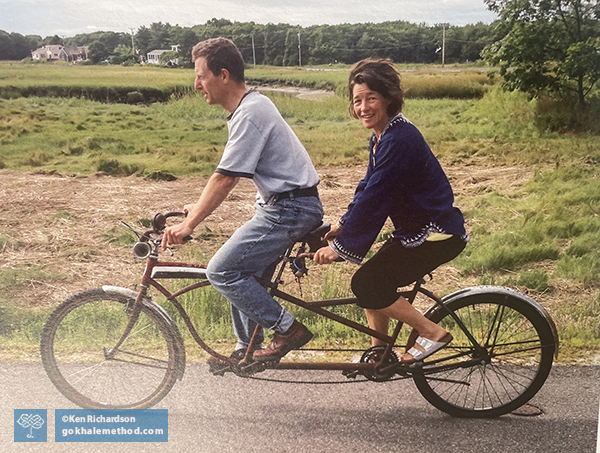
Here Skip and I are both sitting angled forward. Skip is the leader in navigation, I’m leading in posture! My head, shoulders, and behind are further back, where we would like them to be. We’re enjoying quality time working in tandem!
Even holding the handlebars in a relaxed way actually begins with relaxed shoulders that stay open and back. Just because you are reaching forward for something, does not mean the shoulders need to round forward. A tip I offer my children is to do a shoulder roll when we come to a stoplight. This allows the shoulders to “reset” if they have come forward a bit, or even a lot! We teach shoulder rolls in the Gokhale Method as a gentle way to open up the chest and allow the shoulders to rest back where they belong. Teaching this early on is good practice for other daily activities; if one can maintain shoulders back in place while using the arms out front on a bicycle, then keeping them back in place in other contexts, like at a computer, will be easier and become habitual. You can learn how to shoulder roll here.
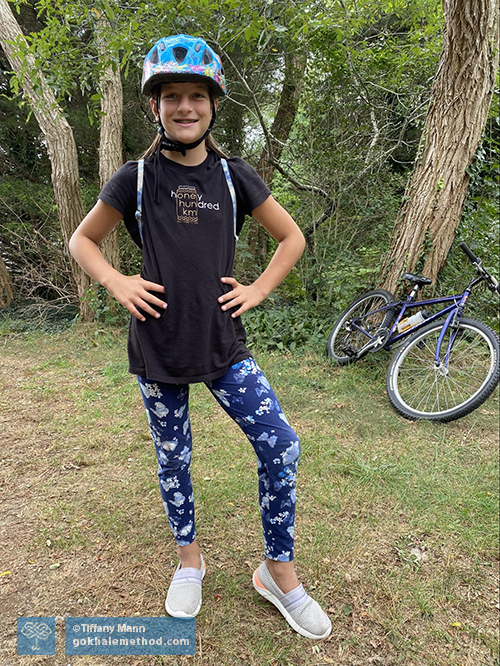
Willa, aged 12, helmet on and excited for a morning bicycle ride on the Cape Cod Rail Trail. One of the benefits of riding a bicycle at any age is the joyousness that comes from moving your body and exploring the world around you.
In fact, nearly all the postural principles that we teach in our in-person Foundations course, Pop-up course, or online Elements course, can help your cycling to become more efficient, healthier, and more comfortable. If you would like expert help with your cycling posture, or to find out more about how our courses could help you with any activity, get started with an online or in-person Initial Consultation with any Gokhale Method® teacher. Or sign up for one of our free online workshops below.
Reference:
¹ “Why Your Kids Should Walk or Bike to School This Year.” Saferoutes Utah. Accessed on July 5, 2022. https://saferoutes.utah.gov/why-your-kids-should-walk-or-bike-to-school-this-year/



Comments
Thanks for the great,
Thanks for the great, informative and well-illustrated article!! I learned a lot and few very inspired to ride my bike!
Ebloustein,So glad you feel
Ebloustein,
So glad you feel inspired to ride your bike! I hope to encouage people, old and young alike, to ride their bikes. If it's been awhile since you've ridden your bicycle, I suggest you get it looked over by your local bike shop; it may need a tune up.
I just bought a bike and am
I just bought a bike and am looking for a seat to add on for my 2 1/2 year old. Do you have any recommendations?
Hello Jaimecruz,Great
Hello Jaimecruz,
Great question!
There are a lot of options out there, and there are various considerations that go into choosing the best child carrier option. Cost, weight, longevity/ease of storage and rideability.
A practical choice is a rack mount child bike seat. Thule makes a great one: the Thule Yeco Maxi Frame Mount Child Seat, for example, comes highly rated.
These are easy to mount and afix to a rack that attaches to the rear of the bike. They are generally easy to take on and off, for when you want to ride without the seat/child. But these seats make for a high center of gravity, which can feel a bit awkward,, as well as being a longer distance to the ground in case of a fall. They are relatively inexpensive and most (the Thule one above for sure) adapt to accomodate a growing child.
Another option is a cargo bike. They are more expensive, but present more options...can carry more than one child (more fun for your kiddo!), can carry groceries and other cumbersome items; in other words, can be used for much more than carrying children. These bikes can be expensive and big, creating storage issues. Many are electric, making them easy to pedal and keep up with your growing child, but can add layer of upkeep to the bike.
Have fun and be safe! Im sure your child will enjoy the ride!
I'd love to hear what other people use and recommend!
Warmly,
Tiffany